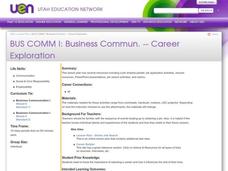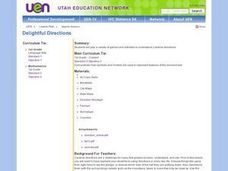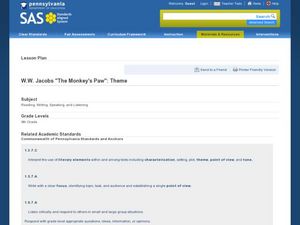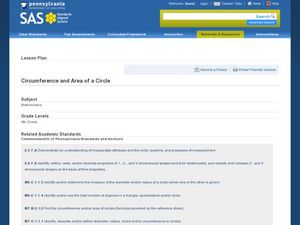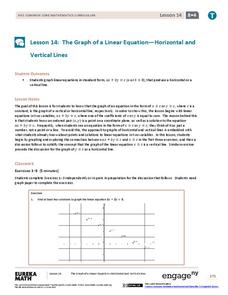Curated OER
Making Pictures from Smaller Shapes
Students investigate shapes. In this dimension and orientation of shapes instructional activity, students identify and color shapes, use shape stamps to form animals, glue shapes together to make other objects and describe how shapes are...
Curated OER
Moving without Wheels
Students observe a simple water cycle model to better understand its role in pollutant transport. This activity shows one way in which pollution is affected by the water cycle; it simulates a point source of pollution in a lake and the...
Curated OER
Homonym Baseball
Sixth graders are introduced to the characteristics of homonyms. In groups, they are given points in the baseball game when the homonyms are matched to the correct definition. To end the lesson, they practice spelling the different...
Curated OER
Lines of Symmetry
Fourth graders demonstrate lines of symmetry using polygons, pentominoes, and block letters of the alphabet. They describe, identify, and analyze characteristics and properties of geometric shapes.
Curated OER
Career Exploration
Students identify the steps needed to apply and receive a job. Using the internet, they find a career they are interested in and practice completing out the application. To end the lesson, they role play the role of the interviewee...
Curated OER
Political Cartoons
Students analyze cartoons by identifying the symbols, characters and information and its significance in history. They examine the economic and political changes in contemporary America. They determine that political cartoons play an...
Curated OER
Delightful Directions
First graders identify and demonstrate how symbols and models are used to represent features of the environment. They identify the directions on a map as east, west, north, and south. Finally, 1st graders play a direction game, move to...
Curated OER
W.W. Jacob's "The Monkey's Paw" Theme
Students identify the theme of "The Monkey's Paw" and relate it to prior knowledge. In this "The Monkey's Paw" lesson, students discuss fate and coincidence and debate which one controls destiny. A test is chosen as the winner based on...
Curated OER
Diagonals to Quadrilaterals II
Learners identify the properties of different polygons. In this geometry lesson, students find the slope of a line and calculate the distance between two lines. They differentiate between similar and congruent polygons.
Curated OER
The Long and Short of It
Fourth graders play a variety of ordering games to identify place value in whole numbers and decimals. They consider the importance of place value in dealing with money.
Curated OER
Pent-up Pentominoes
First graders are introduced to pentominoes in this lesson plan. Using the Internet, they match pentominoes with the same shape and use a grid sheet to make their own. They are read books by their teacher and they identify the...
Curated OER
Layout of preschool
Students examine instruction on the basics of layout of a preschool. They identify appropriate environmental space arrangement and arrange a preschool with centers, easy traffic flow and a workable environment. They study guidelines...
Curated OER
Matter and Change
In this matter and change activity, learners answer 24 questions on topics such as elements, compounds, mixtures and chemical reactions. Students answer questions about the properties of matter such as their physical state and shape. In...
Curated OER
Looking Toward a Higher Deity
Sixth graders study the tenets of the five major religions of the world. In this religion activity, 6th graders investigate the tenets of Buddhism, Christianity, Hinduism, Islam, and Judaism by researching and recording on a matrix. They...
Curated OER
Finding the Circumference and Area of a Circle
Sixth graders discover what circumference is. In this measurement lesson, 6th graders identify the radius and diameter of different circles. Students discover how to find the area of a circle using the radius and diameter.
Curated OER
Line, Ray, Segment
Learners define vocabulary words. In this geometry lesson, students identify the graph as a line, ray or segments. They understand the properties of each and calculate the distance on a number line.
Novelinks
Roll of Thunder, Hear My Cry: Concept/Vocab Analysis
Considering using Roll of Thunder, Hear My Cry for book circles or whole-class study? First time teachers, and those who have used the text before, will find some interesting tidbits in this overview.
Walters Art Museum
The Symbolism of Allegorical Art
Introduce learners to allegorical art with four bronze sculptures by Francesco Bertos. After modeling how to recognize bias and allegory in Bertos' Africa, class groups examine the other three sculptures in the series before creating...
Noyce Foundation
Time to Get Clean
It's assessment time! Determine your young mathematicians' understanding of elapsed time with this brief, five-question quiz.
California Education Partners
T Shirts
Which deal is best? Learners determine which of two companies has the best deal for a particular number of shirts. They begin by creating a table and equations containing each company's pricing structure. Individuals finish the seventh...
EngageNY
The Graph of a Linear Equation—Horizontal and Vertical Lines
Graph linear equations in standard form with one coefficient equal to zero. The lesson plan reviews graphing lines in standard form and moves to having y-coefficient zero. Pupils determine the orientation of the line and, through a...
Maryland Department of Education
The Concept of Identity Lesson 7: Logical Fallacies
What are the effects of competition in an academic environment? The competition between the main characters in A Separate Peace motivates a series of activities that asks readers to take a stance on competition, and then to develop a...
Chicago Botanic Garden
Reflecting on What I Learned About Climate Change
After three eye-opening lessons about our environment, scholars revisit a 10-question survey, reflect on their new-found knowledge, and take action by writing to a representative or creating a public service announcement about climate...
California Education Partners
Least and Greatest
Squares can be magic. Pupils use their knowledge of addition of positive and negative rational numbers to create a 3 X 3 magic square where the sums are 1. Scholars create addition and multiplication expressions with a set of rational...






